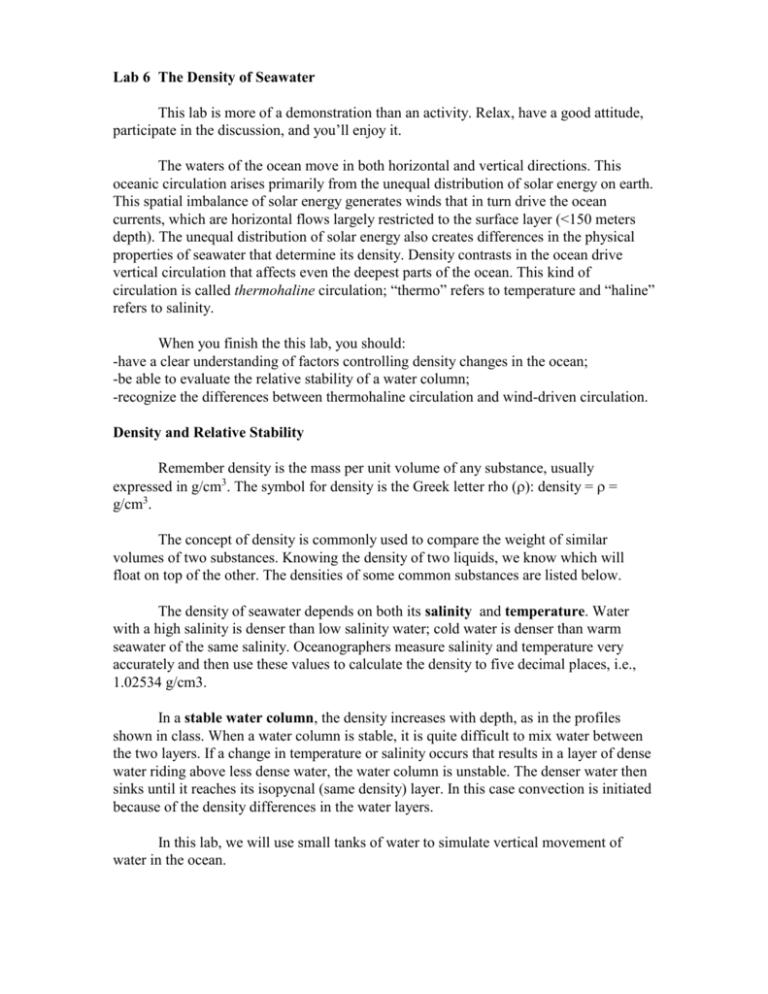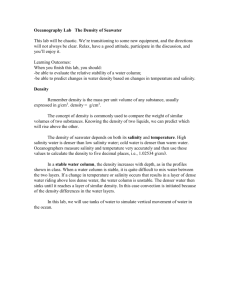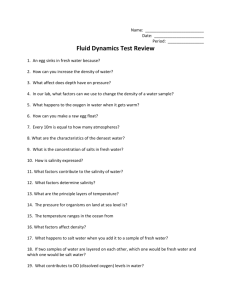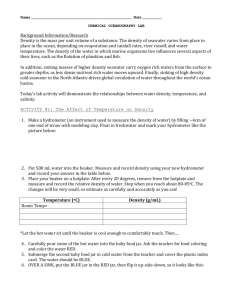Lab 6 The Density of Seawater
advertisement

Lab 6 The Density of Seawater This lab is more of a demonstration than an activity. Relax, have a good attitude, participate in the discussion, and you’ll enjoy it. The waters of the ocean move in both horizontal and vertical directions. This oceanic circulation arises primarily from the unequal distribution of solar energy on earth. This spatial imbalance of solar energy generates winds that in turn drive the ocean currents, which are horizontal flows largely restricted to the surface layer (<150 meters depth). The unequal distribution of solar energy also creates differences in the physical properties of seawater that determine its density. Density contrasts in the ocean drive vertical circulation that affects even the deepest parts of the ocean. This kind of circulation is called thermohaline circulation; “thermo” refers to temperature and “haline” refers to salinity. When you finish the this lab, you should: -have a clear understanding of factors controlling density changes in the ocean; -be able to evaluate the relative stability of a water column; -recognize the differences between thermohaline circulation and wind-driven circulation. Density and Relative Stability Remember density is the mass per unit volume of any substance, usually expressed in g/cm3. The symbol for density is the Greek letter rho (): density = = g/cm3. The concept of density is commonly used to compare the weight of similar volumes of two substances. Knowing the density of two liquids, we know which will float on top of the other. The densities of some common substances are listed below. The density of seawater depends on both its salinity and temperature. Water with a high salinity is denser than low salinity water; cold water is denser than warm seawater of the same salinity. Oceanographers measure salinity and temperature very accurately and then use these values to calculate the density to five decimal places, i.e., 1.02534 g/cm3. In a stable water column, the density increases with depth, as in the profiles shown in class. When a water column is stable, it is quite difficult to mix water between the two layers. If a change in temperature or salinity occurs that results in a layer of dense water riding above less dense water, the water column is unstable. The denser water then sinks until it reaches its isopycnal (same density) layer. In this case convection is initiated because of the density differences in the water layers. In this lab, we will use small tanks of water to simulate vertical movement of water in the ocean. Experiment 1. The Thermocline 1. Fill up tank to mark with hot tap water. 2. Carefully use hose to put ice water into bottom of tank. a. clamp hose onto funnel on stand. b. let air out of hose c. carefully position hose at bottom of tank. d. slowly open valve and let ice water into bottom of tank and fill to second mark. 3. Using two thermometers and two teams, read the temperature every centimeter. a. use thermometer on stand. b. use fastener on stand to move thermometer up from bottom. c. read temperatures every centimeter. 4. record temperatures on graph below, and connect the dots. Do you see the thermocline on the graph? Yes, it should look something like the one shown here on the graph. Can you see the thermocline in the water column? Usually one can see a slight boundary due to the difference in the way that light travels through the warm and cool water. Density decreases with increasing temperature. ______________________________________________ Experiment 2. Stability of a Stratified Water Column. 1. Add dye to a beaker of hot water. 2. Add several eyedroppers of dyed hot water to the tank. 3. Apply a gentle wind across the surface. Remember, this is only a very small tank. Does a gentle wind cause mixing between the layers? No, the layering should not be disturbed by a slight wind. Will a very strong wind cause mixing? Yes, but note how strong your wind probably is scaled to the size of the entire ocean.. In the ocean, wind drift currents are limited to the top 150 meters or so (generally above the pycnocline). Turbulence caused by very strong winds can drive the pycnocline lower. ______________________________________________________________ Experiment 3. the Halocline 1. Fill the tank up to the first mark with fresh water. 2. Using funnel and hose, add 100‰ salt water to the bottom of the tank. Add slowly at first, then add to second mark. When pieces of pumice are dropped into the tank their fall is impeded. Why? The pumice is more dense than the fresh water but less dense than the 100‰ water. If you look closely you can see subtle layering because the two layers of water bend light rays differently. What is bending of light rays called? Refraction. -Density increases with increasing salinity. __________________________________________ Experiment 4. Layering of Ocean Water Masses 1. Fill tank to mark with 15‰ water. 2. Using funnel and stand, carefully add 50‰ water until water reaches second mark. 3. Put 100‰, 35‰, and fresh water in separate, labeled beakers. 4. Put a different colored dye in each beaker. 5. We are going to put these waters into the tank. Where do you expect the different water types to end up? The fresh water on top of the 15‰ water, the 35‰ water above the 50‰ water, and the 100‰ water on the bottom. 6. With eyedroppers, add a few eye-dropper-sized quantities of each of the dyed waters to the tank. Does the water behave as you expected? Yes, it should. -Stability is achieved when a water column has less dense water above and more dense matter below. ________________________________________________ Experiment 5. Effects of Evaporation. 1. Fill beaker with 35‰ water. 2. Float a thin layer of 15‰ dyed water on the surface. 3. Place the beaker under a heat lamp. The lamp should be within one inch of the surface, but not touching the water. What do you expect will happen to the dyed water? Wait a few minutes and watch. Does the water behave as you expected? Is the layer stable or unstable? It should, the water column is unstable. Where would this happen in Nature? At around 30ºN and 30ºS latitudes, where evaporation exceeds precipitation. -Evaporation removes water, but not salt. ___________________________________________ Experiment 6. Effects of Thawing. 1. Fill beaker with 35‰ water. 2. Put dyed ice cubes in the water. What do you expect will happen? Ice will melt and fresh water will float on top of salt water. Wait. Does the melting ice generate a stable layer or an unstable layer of water? The fresh water floating on top of salt water creates a stable layer. Experiment 7. Effects of Freezing. This is a thought experiment, because we can’t freeze water and have you watch at the same time. 1. Imagine a tank of water with 35‰ water in it. 2. Decrease the temperature to below 0C. 3. Watch imaginary ice form. What is the effect of freezing on the water beneath the ice? The water beneath the ice will become saltier because the ice contains only very low salinity water. Does it form a stable layer or an unstable layer? A stable layer—fresh on top of salty water. Where would you expect this to happen in nature? At the poles. Experiment 8. Heat Capacity Heat capacity is the amount of heat required to change the temperature of 1 gram of a substance 1 C°. Alternatively, we could say that the heat capacity of a substance is its ability to absorb or release heat energy without undergoing large temperature changes. A high heat capacity means that a lot more heat can be absorbed or released for a given change in temperature compared to a material with low heat capacity. Every material has a characteristic heat capacity. You will see that the temperature of different substances will increase by different amounts for the same quantity of heat input. This experiment is analogous to the sun heating up the continents and the oceans. Caution: The heat lamps and crucibles used in this experiment get very hot. Do not touch hot lamps or crucibles; keep them on the hot pads provided. Compare temperatures of sand and water before and after heating with a heat lamp for 5 minutes. sand water Initial temp water C° varies varies Final temp C° (after 5 minutes) varies varies Temp change C° Should be higher Should be lower Which material has the greatest heat capacity? The water If the Earth had no ocean would the range of temperatures from the equator to the poles be larger or smaller than it is today? smaller How does water moderate Earth’s climate? The higher heat capacity of water allows the sea water to absorb more heat energy before the temperature increases. Similarly, the seawater is slower to lose its heat and decrease in temperature over time. Thus, the Earth’s temperature is more moderate because of the water on the planet In other words, seawater is much better than the rock on land at absorbing and containing solar heat.









